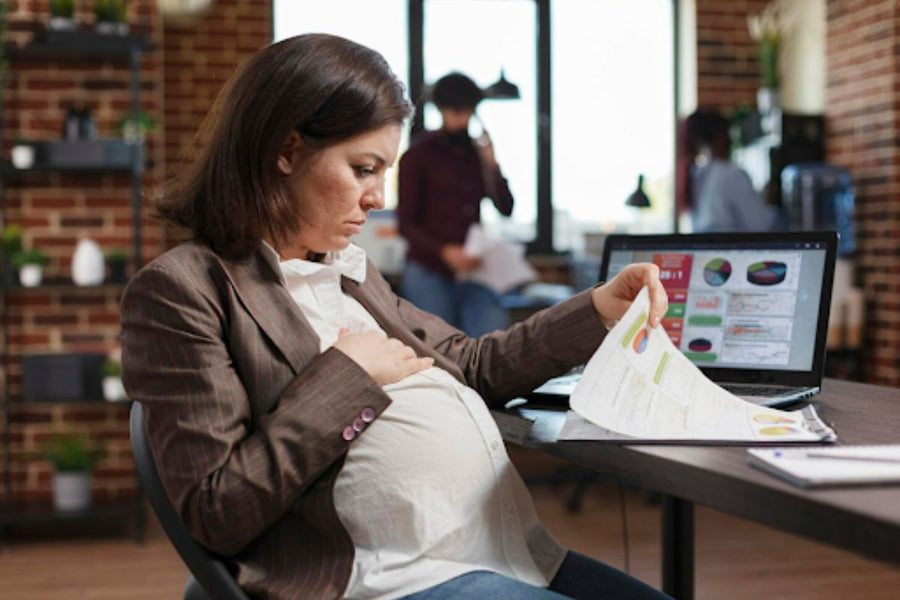Written by Maternity Physiotherapist Sabrina Nieland*
Being a new mom your whole world changes: Just recently you were pregnant and now all of a sudden you're a mom.
Many moms describe the time after giving birth as a roller coaster of emotions. The unconditional love you feel for your baby along with the exhaustion after giving birth and the hormonal chaos caused by the adjustment processes from pregnancy to postnatal regression can be quite exhausting. On top of that your roles in the partnership/family are changing: 2 become 3 (or even more, of course, depending on the family constellation).
Especially first-time parents might be confused by the amount of information and advice available on the internet or from friends/neighbors/family: "You should not lift more than 5 kg", "Your baby has to cry", "Be careful not to spoil him" … just to name a few of some typical phrases...
Welcome to mommy life, welcome to post-partum regression!
This regression stage commonly refers to the first 9 months after childbirth.
"Regression will take as long as the pregnancy lasted"
This is a common phrase for this period. If you take a look at the studies, you will find even significantly longer periods, e.g. the organs need up to 2.7 years until they have regained their full stability.
During the regression process, the physical changes from the pregnancy recede, e.g. your uterus which had been attached to your baby – from about the size of a fist, it has expanded to below the ribs and now needs to shrink back to its original size in the months after delivery. It also takes months for your abdominal muscles, which opened and lengthened during pregnancy as your belly grew, to recover their original stability. The pelvic floor has been prepared for childbirth by hormonal changes throughout pregnancy. By forming small gaps, the pelvis floor softens and is able to expand without injury during birth. This also happens with moms having a C-section, by the way! Therefore, it is also important for cesarean moms to follow the recommendations and postpartum principles as the processes inside you have taken place anyway.
Learn more: Lola&Lykke Experts Answer: How long does it take to fully recover after pregnancy?
Postpartum - the first 6 weeks after giving birth
This is the first stage of the regression process. During this time there is still the so-called lochia, a normal discharge of blood from the uterus, similar to menstrual bleeding. This fluid comes from the internal wound that all moms have after delivery caused by the placenta detaching at the end of giving birth. Did you know that this wound is about the size of a breakfast plate?

Your body has done a great job, give it a break. During the postpartum period, it is important that you take it easy. This means that you should lie down a lot and not move around too much. Since the uterus is still huge and heavy at the beginning (after delivery approx. 1.5 kg!) and the pelvic floor is still very soft, it will help you to lie on your stomach often, ideally with a small pillow under your lower belly or in supine position with a pillow under your buttocks.
During the postpartum period, you should not exercise a lot or do any heavy weightlifting beyond what is necessary. If possible, you should not carry your baby around in a car seat, but rather in your arms, in a sling or preferably with the help of someone else. Shortly after delivery, your body is not yet resistant to pressure. Most mothers notice some sort of pressure in the direction of the pelvis or the belly when they have to stand or walk for a long time.
Of course, you can go for a short walk and try some breathing techniques and light exercises for the pelvic floor and your abs to help your body to recover. Ask your midwife for a recovery plan for the postpartum period.
Learn more: The Truth Behind “Bouncing Back” And What You Should Really Focus On Postpartum
6-8 weeks (after a C-section approx. 10 weeks) after giving birth
You might want to start a postnatal regression course. Under the supervision of a midwife or a physiotherapist, you will learn to wake your core from its slumber, i.e. you will do specific exercises to perceive and activate your deep abdominal and pelvic floor muscles, which are often still very weak after childbirth. A good postnatal course should also deal with breathing techniques, posture, daily behavior, diastasis recti as well as pelvis issues or other physical pain and symptoms.
Regression ≠ Exercising
One thing that is widely wrongly assumed is that regression is a workout. But: Actually, it does not aim to make you lose weight or help you to get a flat stomach … even though you may be disappointed now. The regression course is essential to stabilize your core from the inside out, so that you can ideally return to other sports afterwards without any problems.
Another misconception is that one regression course is enough. “I have done my regression, so now I can do everything again just as I did it before pregnancy" is something I often hear in my pelvic floor therapy. But the regression processes also continue after the course (see above).
Even if pregnancy and giving birth do not compare to a sports injury: think of the recovery phase as a rehabilitation period after a knee surgery - no one would think of immediately throwing away the crutches after 9 months of using them and immediately going back to their normal running routine, for example. That probably wouldn't work either, since the muscles have weakened and the body is deconditioned … so you would slowly rebuild your body and get used to exercising gradually. So why would it be any different after pregnancy and giving birth?
Learn more: I had a caesarean section, so I don't need to attend postnatal physiotherapy, do I?
My advice
Give your body some time to recover its strength and shape. Slowly increase the intensity and be alert to symptoms: If you experience any pressure, urine leakage or pain in the pelvic floor area, speak to your gynecologist or an expert. There are many specialized therapists and postanatal trainers who can help you with symptoms or with getting back into sports.
Have any question? Talk to Lola&Lykke's experts! Motherhood shouldn't be done alone - let's do it together!. Our expert panel is private, free-of-charge and backed by our Maternal healthcare experts.
Introducing Lola&Lykke Core restore postpartum belly band
Our postpartum belly band with innovative dual compression technology provides much-needed support for weakened, unstable core muscles after childbirth. The belt offers comfortable dual-layer support for your core, hips, and back post pregnancy, alleviating back pains and improving posture. The band helps to gently realign your abdominal muscles, reducing the appearance of ´mummy tummy´. The gentle compression expedites fluids through the body and accelerates recovery from pregnancy and labour.
- Latex-free, breathable, hypoallergenic
- Medical Grade Quality
- Suitable for both vaginal and c-section recovery
- Adjustable dual compression system for optimum comfort
You can find more details about the band here.



